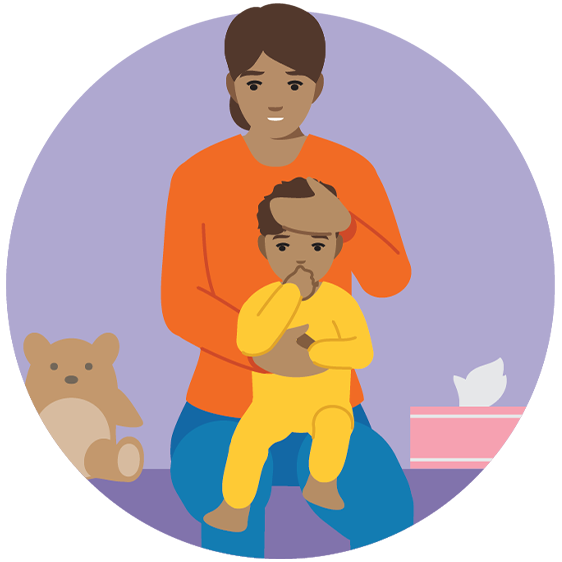Know the symptoms: Cold, flu, RSV, or COVID-19
What viruses are going around?
The common cold, influenza (the flu), and respiratory syncytial virus (RSV) are seasonal, meaning they’re more common at specific times of the year — though you can catch a virus anytime.
Colds are more common in late winter and early spring. The flu and RSV are common during the late fall and winter months.
While there’s no established seasonal pattern for COVID-19 yet, some health experts expect there to be more cases between late fall and early spring.
- The common cold is the most common infection of the nose, sinuses, or throat. Symptoms tend to be mild and get worse over a few days.
- The flu usually involves symptoms that are worse than a cold and come on faster. People sometimes use the term “flu” to describe a cold or stomach virus. But the flu usually doesn’t cause vomiting or diarrhea in adults.
- RSV is more common in children than adults. It usually causes mild symptoms. In some people, especially young children, it can lead to conditions that make breathing difficult, like pneumonia. Older adults may take longer to recover from RSV.
- COVID-19 affects the lungs and airways. Most people have mild symptoms, but some can become severely ill.
There are tests to find the flu, RSV, and COVID-19 viruses. Flu and RSV tests are usually only given to people who are hospitalized with severe symptoms. For most COVID-19 testing needs, home antigen tests are a quick and easy way to find out whether you have COVID-19. There’s no test for the common cold.

Is it a cold, the flu, RSV, or COVID-19?
These viruses all cause similar symptoms, like fever and cough. It can be difficult to know which infection you or your child has. Be sure to track your symptoms so you know when to contact your doctor. Here are the most common and rarest symptoms, to help you understand the similarities and differences among these viral illnesses.1
Cold
Cold symptoms come on gradually and are usually mild.
Common symptoms:
- Cough
- Runny or stuffy nose
- Sneezing
- Sore throat
Rare symptoms:
- Chills
- Diarrhea or vomiting
- Fever over 100 degrees
- Loss of taste or smell
- Shortness of breath
- Wheezing
Flu
Flu symptoms come on suddenly and are often severe.
Common symptoms:
- Chills
- Cough
- Fatigue or weakness
- Fever over 100 degrees
- Headache
- Muscle pain or body aches
- Runny or stuffy nose
- Sore throat
Rare symptoms:
- Loss of taste or smell
- Wheezing
RSV
RSV symptoms come on gradually. They can be severe in young children and older adults.
Common symptoms:
- Cough
- Fever over 100 degrees
- Headache
- Runny or stuffy nose
- Sneezing
- Sore throat
- Wheezing
Rare symptoms:
- Chills
- Diarrhea or vomiting
- Loss of taste or smell
- Muscle pain or body aches
COVID-19
COVID-19 symptoms come on gradually and range from mild to severe.
Common symptoms:
- Chills
- Cough
- Fatigue or weakness
- Fever over 100 degrees
- Headache
- Runny or stuffy nose
- Sore throat
Rare symptoms:
- Wheezing

What to do if you feel sick
It’s best to stay home when you feel sick to avoid spreading your infection to others. Cover your cough and wear a mask when you need to leave home.
If you’re at high risk for serious illness from COVID-19, take a COVID-19 home antigen test when you start to feel symptoms of a respiratory infection. If your test result is positive, ask your doctor about COVID-19 medication.
Keep track of how you’re feeling. For most healthy people, respiratory infections like the flu, RSV, and COVID-19 will go away in about 7 to 10 days. If you’re sick for longer than that, have severe symptoms, or are at high risk for complications, contact your doctor. Learn more about when to seek care.
Your doctor won’t prescribe antibiotics for a cold or flu as they don’t work on viruses. You can manage your or your child’s symptoms by:
- Getting extra rest
- Drinking plenty of fluids
- Taking acetaminophen (Tylenol) or ibuprofen (Advil, Motrin) for fever or pain2
- Flushing nostrils with saline nasal drops
Need care now? We’re here to help.
You have many convenient ways to get care — in person or from the comfort of your home. And if you have symptoms when you’re away from home, you’re covered for urgent and emergency care anywhere in the world.
Additional resources
Footnotes
1Information doesn’t include all possible symptoms. COVID-19 symptoms may change with new variants and depending on vaccination status.
2Kaiser Permanente doesn’t endorse the medications or products mentioned. Any trade names listed are for easy identification only.


